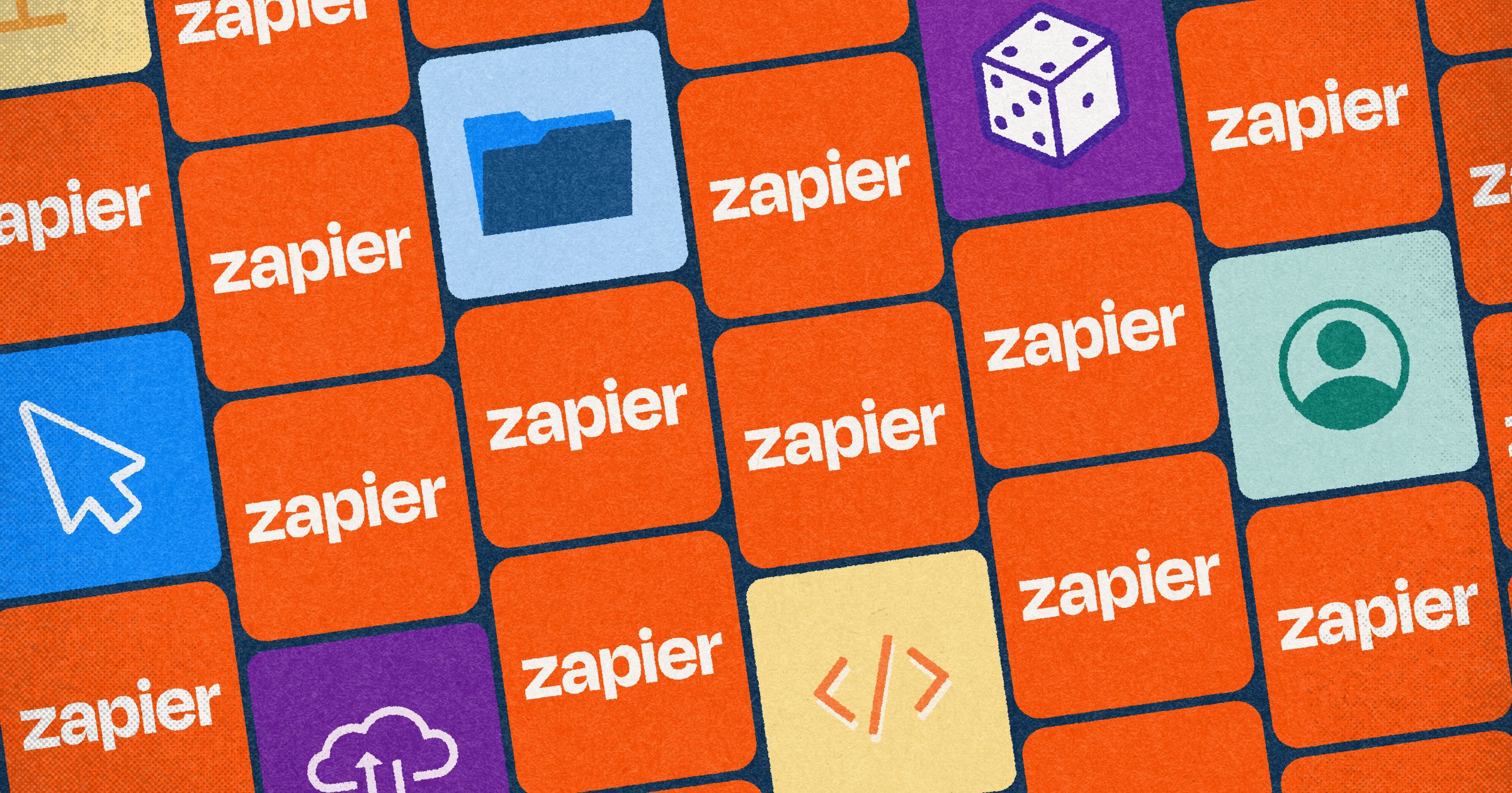
11 Zapier Alternatives and Competitors in 2025
Zapier alternatives comes in all shapes and sizes, and trying to find the ideal one for you can be really time-consuming. In this blog I break down my pick of the best Zapier alternatives, to save you time and help you to make the right decision for you.
Zapier is an online automation tool that allows you to connect your favorite apps, including Gmail, Slack, Mailchimp, and more than 3,000 others. It enables you to automate repetitive tasks between different applications without the need for coding or technical skills.
In Zapier, these automated workflows are called “Zaps,” and they consist of a trigger and one or more actions. The trigger is an event in one app that starts the automation, and the actions are the tasks performed in other connected apps.
For example, you could set up a Zap to automatically send an email notification whenever you receive a new message in a specific Slack channel or add new leads from a Google Form to your CRM system. Zapier supports a wide range of integrations, making it a versatile tool for streamlining and automating various processes in your workflow.
However, Zapier isn’t the only automation tool on the block. And if you’re looking for an alternative to Zapier – either because you need something specific to meet your needs or you’re just looking for a less pricey way to handle automations, we’ve got a list of 11 of the best Zapier alternatives for you.
Zapier Pros & Cons
If you’re new to automation tools, you may be asking why is Zapier so dominant? There are a few major reasons why people go for Zapier:
- It’s got more integrations that any other solution in the market
- It’s an easy-to-use no-code solution
- It’s scalable – you can use it for small and large businesses.
That being said, there are a few negative aspects to the tool as well:
- Zapier is expensive – sometimes significantly more so than competitors
- There are limits to its integrations. Some work better than others, and you have to test them out to discover where you might have problems
- The customer support can be slow to respond
Zapier Costs
Of the items on the “con” list, the one that convinces most people to jump to a new solution is the price. Not long ago, Zapier raised their prices – an increase that caught many users off guard.

Zapier plans have a base price that increases with the number of tasks you perform in a month. Here’s a rundown of their current pricing:
- Free: Limited to 2-step automations
- Starter: $19.99+ per user per month (annual plan)
- Professional: $49+ per user per month (annual plan)
- Team: $69+ per user per month (annual plan)
- Company: Contact Zapier for pricing
These are just the base prices, however. If you perform a lot of tasks via your automations, the charges can increase pretty substantially. For instance, if you use 10,000 tasks a month, it’ll boost a Professional Plan to $129 per month.
Since so many people look for Zapier alternatives based on price, we’ve listed the prices for all the apps on our list and added context, so you can make an informed decision.
Zapier Alternative #1: Visor
If you want to improve how you visualize and share Jira, Salesforce, or Asana data, Visor gives you a unique visualization tool for your kitbag. Visor automatically syncs your data from Jira, Asana, Salesforce, and other sources, in visualizations that can be easily understood and shared with stakeholders.
Visor offers a different way to, for example, integrate Jira and Salesforce data, or combine your Asana and Salesforce data. It enables you to merge this data, either to create high level views that combine multiple apps as data sources, or to enable collaboration across different teams and apps.
You can also use Visor to manage your portfolio of projects, combining multiple projects from one or many apps into single, portfolio level views. This gives you the crucial capabilities of a project portfolio management (or PPM) tool that is suitable for the objectives and budget of small-large sized organizations.
Table View in Visor combining Asana and Salesforce data together in a sharable table:
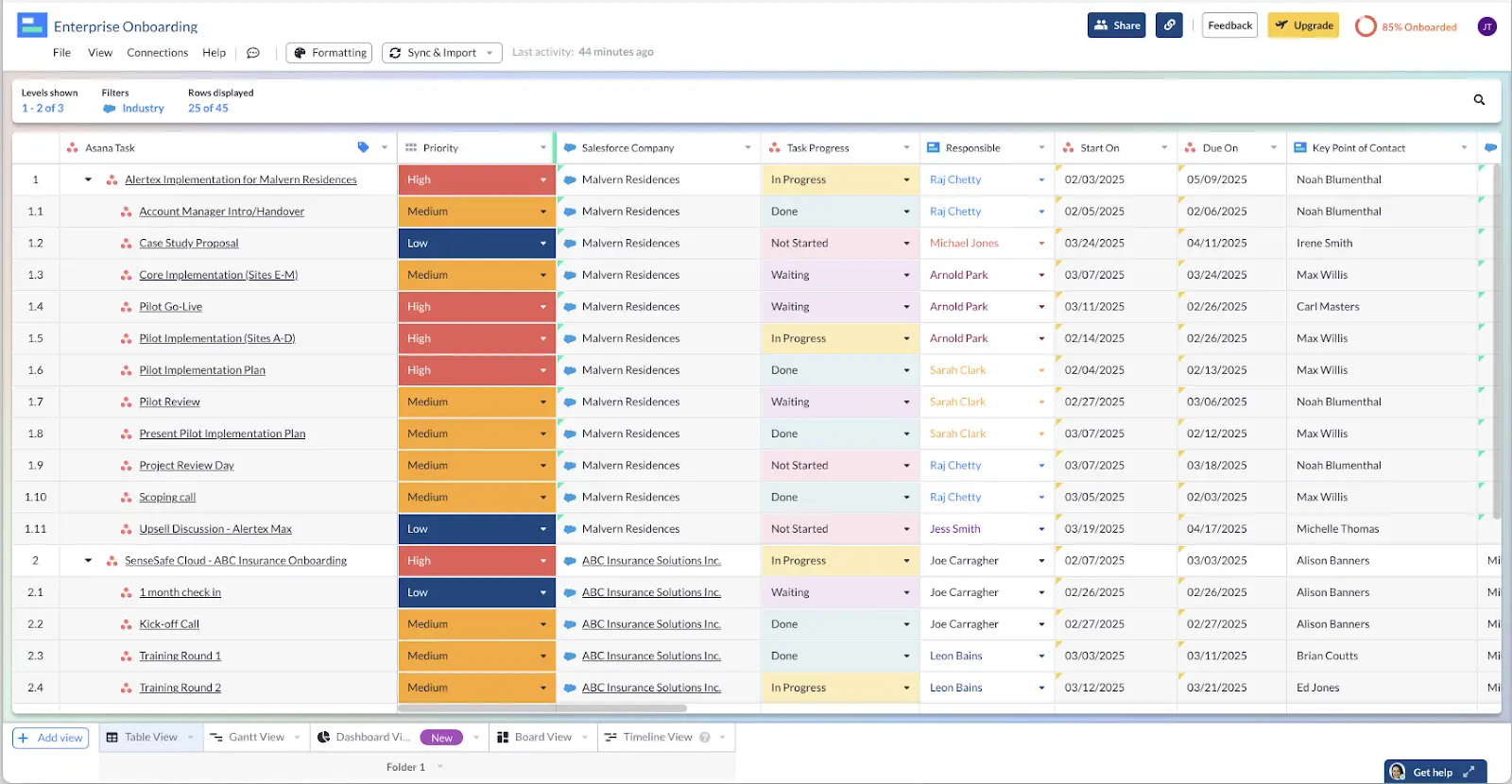

Unlike Zapier, Visor doesn’t have “if this, then that” automations. Rather, Visor is more centered around collaborating with the data in other apps and automatically updating the data that you share with others. Think of it as Zapier for collaboration.
Visor Features
- Allows multiple views, including:
- Preserves hierarchies from outside sources, like Jira and Asana
- Has two-way integrations with popular SaaS apps
- Provides a single source of truth for data
- Offers custom fields, conditional formatting, and filtering
Visor Pros and Cons
Pros:
- The tool sets up a bi-directional sync between Visor and apps like Jira
- Communication between Jira and Visor is faster than it would be with middleware like Zapier
- Visor is simple to learn and use
- It offer secure, straightforward collaboration
Cons:
- Offers a limited number of connections and automations
Visor pricing
Charges are based on the number of editors, or people making changes to your Visor account. However, you’re allowed unlimited viewers with no affect on pricing.
- Free: Offers a limited number of workbooks
- Pro: $9 per editor per month (annually)
- Ultimate: $18 per editor per month (annually)
Visor reviews and rating
- 4.5 out of 5 on Capterra
- 5.0 out of 5 on G2
Reviewers noted they are happy with the product and looking forward to additional features being added in the near future.
Zapier Alternative #2: Make (formerly Integromat)
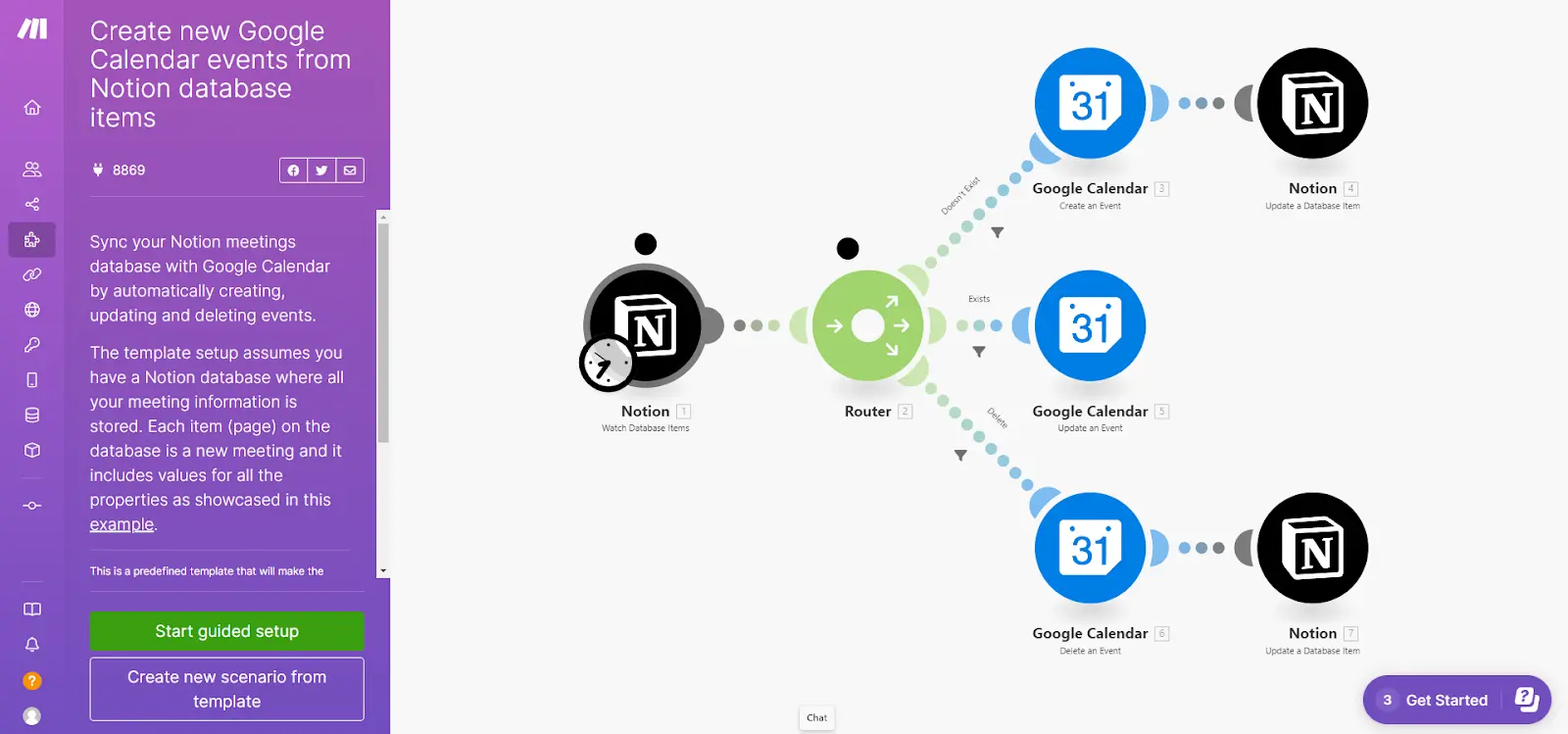
Make, formerly known as Integromat, is one of the biggest contenders for Zapier’s crown. It comes with 1200 apps already built in, with the ability to connect to others via API. It also has a highly visual interface that makes it easier to see how apps are connected and what your automation is going to do. Add to that its thousands of pre-built automation templates, and you have a solution that’s a good choice for those new to setting up automations.
Make Features
- Integration hub to connect to favorite tools
- No-code drag and drop interface
- Ready-made automation templates
- Over a thousand integrations
Make Pros and Cons
Pros:
- Make supports a wide range of integrations with popular apps and services, providing users with flexibility in connecting various tools within their workflows
- The highly visual drag-and-drop interface is easy for users of most ability levels
- When you set up an automation in Make, you can use data from an earlier date (something you can’t do in Zapier)
Cons:
- Make can be slow when dealing with large files or complex workflows
- Though it costs less than Zapier, the costs can still add up
- More complex workflows have a steep learning curve
Make Pricing
Pricing is based on the number of Ops you perform a month. Each of the price tiers below start at 10,000 Ops per month (with the exception of the Free tier) and the price you pay goes up based on the number of Ops you use. As a result, you can see your monthly fee go up if you use more operations than you budgeted for that month.
- Free: Limited to 1000 Ops
- Core: $9+ per user per month (annual plan)
- Pro: $16+ per user per month (annual plan)
- Teams: $29+ per user per month (annual plan)
- Enterprise: Contact Make for pricing
Make Reviews and Ratings
- 4.8 out of 5 on Capterra
- 4.7 out of 5 on G2
Reviewers noted that the functionality is similar to Zapier, but with a much lower price point. Some reviewers noted it is sometimes difficult to track exactly when you’ll need a new pricing tier.
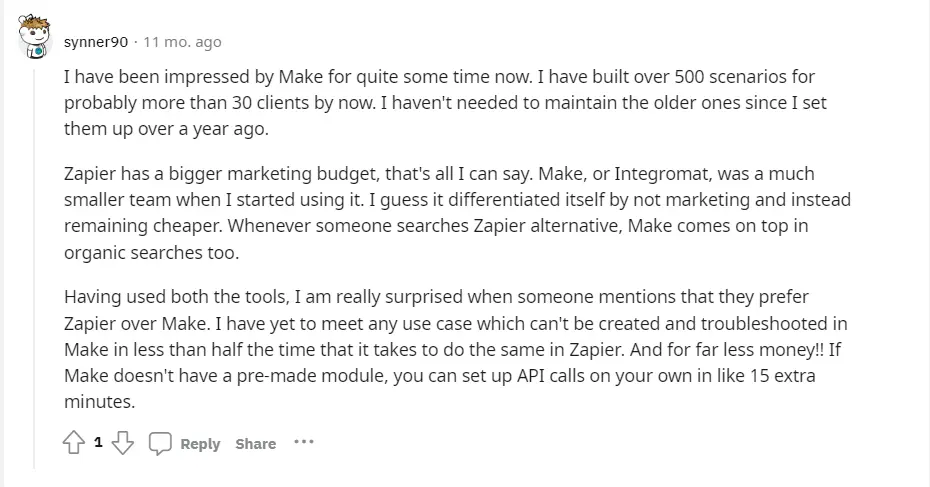
Zapier Alternative #3: Tray.io
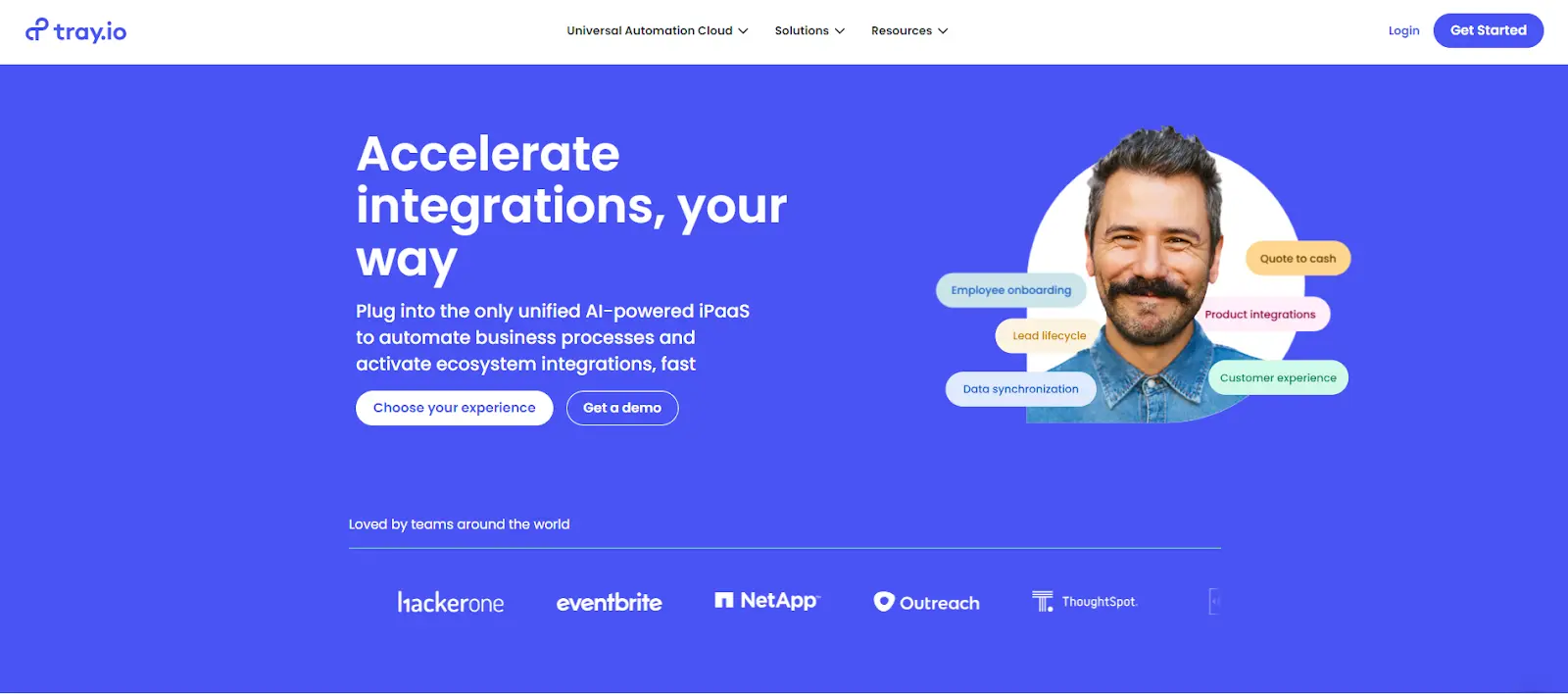
If you’re willing to dip your toes into low-code waters, Tray.io is a solid choice. Tray.io offers both a visual interface and the ability to code automations. You’ll get 600+ connectors, as well as a universal connector that works with all RESTful APIs when Tray.io doesn’t have a straightforward connector.
Tray.io tends to run a higher price tag, making it more suitable for enterprise rather than SMB customers. However, that enterprise price comes with enterprise features, like access controls, monitoring, and logging.
Tray.io Features
- Drag-and-drop automations
- 600+ connections
- Conditional logic to handle multiple scenarios
- Universal connector that works with RESTful APIs
Tray.io Pros and Cons
Pros:
- The visual workflow builder makes it easy to set up triggers
- You can connect to any RESTful APIs
- The tool offers additional security features like access controls, monitoring, and logging
- The apps design ensures automations rarely fail because of data inconsistencies
Cons:
- It can take a little more time to learn than some of the other drag-and-drop options on this list
- Higher pricing targets enterprise rather than SMB customers
- Tray.io’s functionality is dependent on the APIs provided by third-party applications. Changes in these APIs may impact the functionality of existing workflows.
Tray.io Pricing
Tray.io doesn’t publish pricing on their homepage, and they don’t offer a free option.
Tray.io Reviews and Ratings
- 4.9 out of 5 on Capterra
- 4.5 out of 5 on G2
Some reviewers have said Tray.io is more complicated than systems like Zapier, but the increased flexibility and security make it worth it.
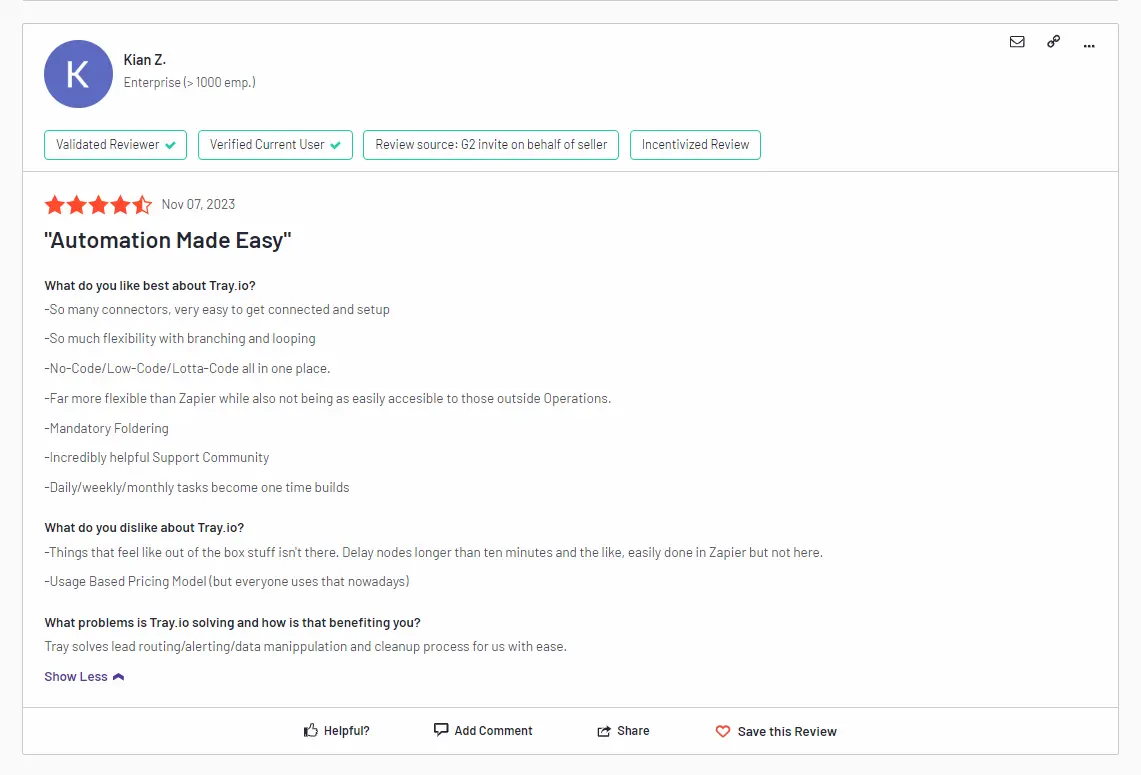
Zapier Alternative #4: Workato
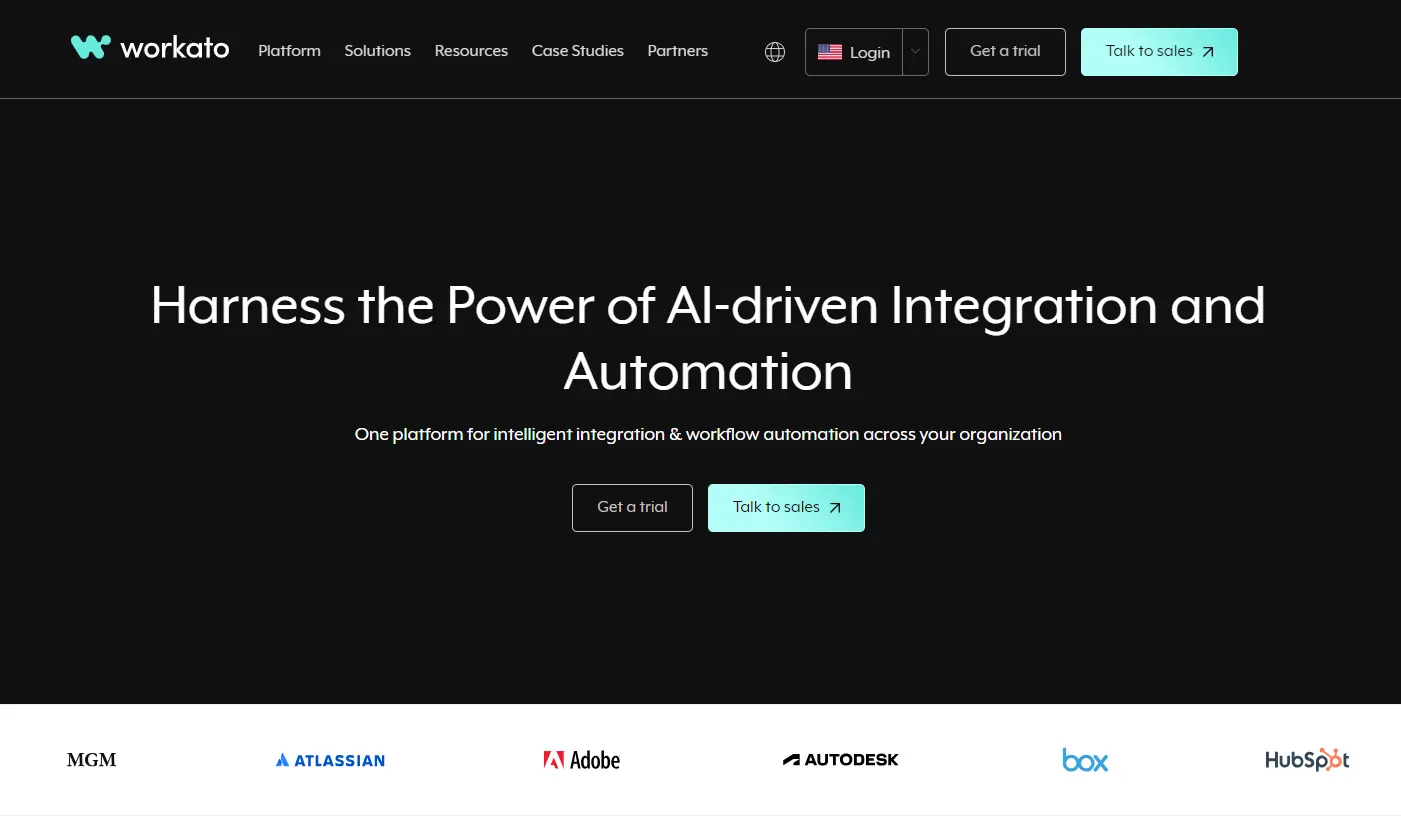
Workato is truly designed for enterprise, with automations that work for IT, marketing, human resources, sales, and so on. As part of that enterprise focus, Workato features top-tier security with an assortment of compliance certifications to back it up.
In terms of functionality, Workato has over a thousand apps and services it links to and more than 50,000 pre-built “recipes” – sets of automations that you can use like templates. You buy a basic workspace to start, then you add recipes on an as-needed basis.
Workato Features
- 1000+ connections to apps and services
- Offers ready-to-use automations called “recipes”
- Automations can have multiple complex steps
- Automations can be built in UI or via API
Workato Pros and Cons
Pros:
- It prioritizes security and is used by several major security-conscious clients like Atlassian, Adobe, and Zendesk
- You won’t lose data if there’s an interruption in service (the same can’t be said of Zapier)
- 500,000+ existing recipes you can use for common processes
Cons:
- This is an enterprise solution with enterprise pricing.
- It’s a less intuitive solution that may take longer to learn
Workato Pricing
Workato doesn’t publish pricing on their homepage, and they don’t offer a free option.
Workato Reviews and Ratings
- 4.7 out of 5 on Capterra
- 4.7 out of 5 on G2
Most reviewers enjoyed the broad capabilities Workato offers, but noted there’s a big learning curve for most users.
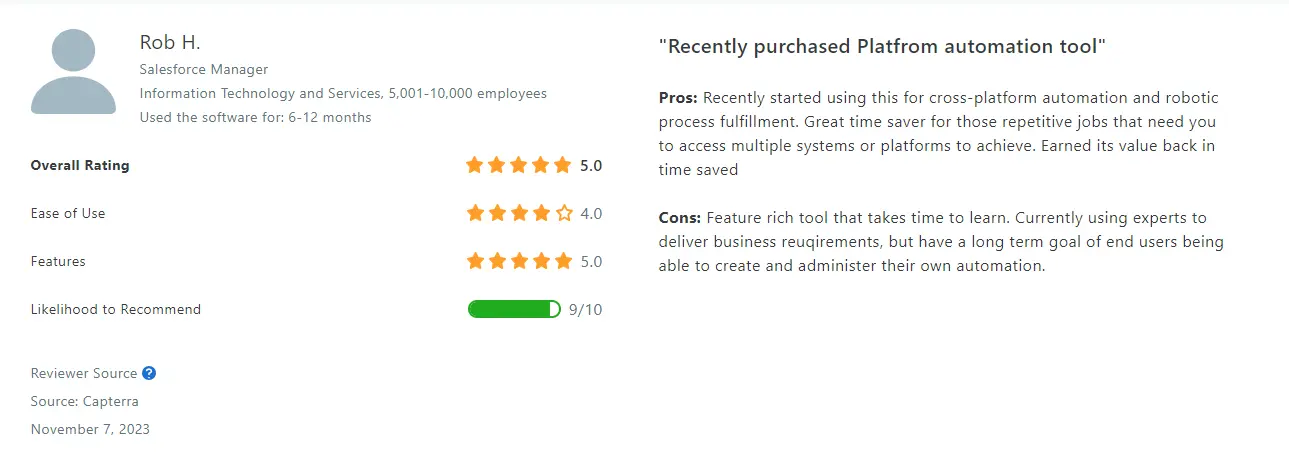
Zapier Alternative #5: Integrately
Integrately might be one of the easiest automation apps out there. The automation software is no-code and offers approximately 15 million one-click automations for 1,100 apps and services. It also offers an AI that can help you build your own custom automations.
It’s clear Integrately is gunning for Zapier – it has a similar automation generator and specifically calls out its lower price tag on its website.
Integrately Features
- 15 million one-click automations
- Connections to 1100 apps and services
- Integrately AI that can manufacture automations
- Ability to create simple and complex workflows
Integrately Pros and Cons
Pros:
- Integrately offers millions of one-click automations that simplify automation-building
- The app seems to be rapidly adding new apps and services – it now claims 1100 apps as opposed to 700 last year
- It’s significantly less expensive than Zapier
Cons:
- More advanced workflows may be difficult to manage with this solution
- It can be difficult to troubleshoot errors in Integrately.
Integrately Pricing
Integrately has a pricing structure similar to Zapier, but with major differences based on the per task price. For instance, 2,000 tasks in Integrately is $19.99 per month; the same number of Zaps in Zapier is a minimum of $49.00.
- Free: Limited to 100 tasks
- Starter: $19.99 per month (annual plan)
- Professional: $39 per month (annual plan)
- Growth: $99 per month (annual plan)
- Business: $239 per month (annual plan)
Integrately Reviews and Ratings
- 4.7 out of 5 on G2
Most reviewers mentioned a little initial difficulty adapting to a new tool, but were otherwise happy with Integrately.
Zapier Alternative #6: IFTTT
IFTTT (which stands for “If This, Then That”) is actually about a year older than Zapier. And it’s found success in a slightly different style of automation. Instead of being all business, IFTTT places its emphasis on both apps and the Internet of Things. For instance, you can manage your refrigerator, post a tweet, or save songs to your Spotify all from the same spot.
It’s got a more B2C bent than most of the tools listed here, but that’s a feature not a bug. However, it may not be the right tool for a larger enterprise with more complicated workflows.
IFTTT Features
- Connects to both business and home tools
- Basic automations created using “Applets”
- Offers both iOS and Android apps
- AI workflow creator (in beta)
IFTTT Pros and Cons
Pros:
- IFTTT offers a relatively low price point
- It allows you to connect to personal apps and home appliances
- Tech novices will find this tool easy to use
Cons:
- This tool may be too basic for users looking for more complex workflows
- Certain apps, like Pinterest, are gated behind the paid version of the product
- Though there are ready-made Applets, creating your own custom workflow is a little more difficult
IFTTT Pricing
With only 2 Applets (workflows) allowed, the Free plan is really more of a test drive than anything else. The Pro plan only goes up to 20 Applets a month, so if you’re looking to use this for business, you’ll probably want the Pro+ plan.
- Free
- Pro: $3.33 per month
- Pro+: $12.50 per month
IFTTT Reviews and Ratings
- 4.5 out of 5 on Capterra
- 4.6 out of 5 on G2
Most reviewers were happy with the ease and use and price; however some complained about the limitations of IFTTT’s simple setup and others felt the price was too high for a tool they maintained for personal or very light business use.
Zapier Alternative #7: Outfunnel
Outfunnel is a specialized automation tool that lets you keep your sales and marketing data in sync. It’s more highly specialized and is designed specifically to connect CRM information with other sales and marketing apps.
Outfunnel lets you share marketing engagement data with Sales and keep your contact lists in sync across sales and marketing. While it offers a much smaller list of apps than Zapier, if you’re primarily looking to connect sales and marketing tools, Outfunnel is designed for you.
Outfunnel Features
- Sales- and marketing-focused app
- Connects to most CRMS
- Will scale based on your number of contacts
- Stores and shares customer data
Outfunnel Pros and Cons
Pros:
- This is a tool designed for your sales marketing workflow
- You can add lead scoring and marketing automation features.
- Outfunnel works well with most major CRM tools
Cons:
- Because it’s so specialized, you’ll be working with a smaller number of apps
- Features are a bit more basic than with other automation tools
Outfunnel Pricing
Outfunnel charges based on the number of Active Contacts you have in a given month, and plan prices go up based on the number of unique monthly contacts. The app offers a 2-week free trial if you’d like to test it out before purchasing.
- Basic: $29+ per month (annual plan)
- Pro: $119+ per month (annual plan)
- Scale: Contact Outfunnel for details.
Outfunnel Reviews and Ratings
- 4.9 out of 5 on Capterra
- 4.3 out of 5 on G2
Reviewers noted that the Outfunnel team was quick to respond and that the tool was overall able to meet their needs.
Zapier Alternative #8: Pipedream
From Pipedream
If you’re a more technical user who wants a low-code rather than a no-code solution, Pipedream gives you the flexibility to code your own automations. Pipedream lets you code in Node,js, Python and more, as well as offering artificial intelligence features that suggest code for your automations.
Pipedream Features
- 1,700+ available integrated apps
- Support for Node.js, Python, and more
- AI provides autocomplete suggestions for code
- Ability to track events and debug as you work
Pipedream Pros and Cons
Pros:
- You have full control of your code with support for multiple coding languages
- An AI automation tool is available to help you put together your workflows
Cons:
- Pipedream is less friendly to automation beginners or those without any coding experience
- Some users have complained about a lack of documentation
Pipedream Pricing
Instead of charging based on actions or workflows, Pipedream uses credits. You can set daily or monthly caps to control charges. For an active workflow, “each credit represents 30 seconds of compute time with 256MB of memory,” according to Pipedream.
- Free: Offers 750 credits per month; 25 credits per day
- Basic: $19 per month (annual plan)
- Advanced: $49 per month (annual plan)
- Business: $99 per month (annual plan)
- Enterprise: Contact Pipedream for details
Pipedream Reviews and Ratings
- 5.0 out of 5 on Capterra
- 4.6 out of 5 on G2
A few reviewers noted the recent price increase and that Pipedream has fewer integrations than Zapier. However, more noted the time-saving flexibility this low-code solution offers.
Zapier Alternative #9: n8n
The n8n team prides itself on providing “Workflow automation for technical people”. So while it does offer no-code options, this is really a solution for users who want to manage simple automations using no-code tools and break out their coding skills for more complex automations.
n8n Features
- Includes no-code and coding options
- Handles branching, merching, and iteration
- 1000 workflow templates available
- Offers self-hosted option for Enterprise customers
n8n Pros and Cons
Pros:
- Allows for more personalization than some tools that don’t allow for coding
- The app offers development and production environments, so you can test new workflows without messing up existing automations.
- Data is displayed along with settings to simplify debugging
Cons:
- n8n has gone from free and open source to a paid plan, which has been a major adjustment for existing users
- It is a very technical solution, meaning there’s a higher difficulty threshold for new users
- Users have reported limited documentation
n8n Pricing
The n8n pricing structure changes based on a full workflow execution, not based on individual operations.
NOTE: If you have some technical knowledge, you can install a Community Version of n8n for free. However, if you prefer a no-code alternative, they offer the following plans:
- Starter: $20 per month (annual plan)
- Pro: $50 per month (annual plan)
- Enterprise: Contact n8n for details.
n8n Reviews and Ratings
- 4.6 out of 5 on Capterra
- 4.8 out of 5 on G2
Reviewers noted technical knowledge is a must here, with some reviewers saying they took classes to get the hang of the system. While n8n is often listed as open source, some users took issue with this label because of changes to the pricing structure and limitations on the free version of the product.
Zapier Alternative #10: Microsoft Power Automate
Via Microsoft
Power Automate is the only app on this list that also allows you to automate desktop processes as well. With some powerful AI features that allow you to create workflows based on text descriptions or that can suggest changes to your code, there’s a lot you can do. In addition, you’ll get plenty of support for other Microsoft products.
However, this is a complex, enterprise solution, so you’ll need a bigger budget as well as time to train your users.
Microsoft Power Automate Features
- AI Builder creates workflows based on text descriptions
- Includes 1000s of pre-built automation templates
- Allows you to automate non-API systems (like programs on your desktop)
- Can suggest changes to your workflows to make them more efficient
Microsoft Power Automate Pros and Cons
Pros:
- The tool offers strong integrations with other Microsoft products
- Its Process Advisor can recommend ways to make your workflows run more efficiently
- You can automate both desktop and API-based tasks, allowing more scope for the types of workflows you can create.
Cons:
- Pricing is on the higher end of things, making this more an enterprise solution than one for SMBs
- It can be more complicated to learn than some of the other automation tools on this list.
- Users report occasional reliability issues
Microsoft Power Automate Pricing
Power Automate does offer a free trial. Their payment system is unique – the primary method is by-the-user charge, which can add up quickly at an enterprise organization. You can also license an automation bot to handle desktop or API automations.
- Power Automate Premium: $15 per user per month
- Power Automate Process: $150 per bot per month
Microsoft Power Automate Reviews and Ratings
- 4.4 out of 5 on Capterra
- 4.5 out of 5 on G2
Reviewers were happy about the ease with which tasks could be automated – once you learned how to use Power Automate. The most common complaint was the learning curve to get a handle on the tool.
Zapier Alternative #11: Pabbly Connect
Pabbly Connect is looking to build a lifetime client base, which is clear from their payment plans. They offer discounts to users who sign up for a one-time lifetime subscription payment. It’s one of the many things Pabbly does differently.
They also don’t charge for internal tasks, like filters or routers, and don’t have premium apps (a feature in Zapier). This makes it a good choice for smaller businesses looking to automate processes, but costs can add up if you need to run a significant number of tasks.
Pabbly Connect Features
- Drag-and-drop workflow builder
- Folder management capabilities
- Offers a pay once, get a lifetime of usage plan
- Internal functions don’t count towards your monthly task limit.
Pabbly Connect Pros and Cons
Pros:
- Triggers and internal tasks are free
- Pabbly connect has more than 6,000 tutorials to help you with whatever you need to accomplish and a very active Facebook support group
- There are no limitations of premium apps or services – you’re able to use all the available apps regardless of plan
Cons:
- Pabbly doesn’t have live chat support if you need direct help
- Troubleshooting issues can be difficult
- Users may need to understand webhooks, APIs, and data mapping to get full value out of the product
Pabbly Connect Pricing
Pricing for Pabbly Connect depends on which type of plan you choose and how far in advance you want to pay. Pabbly offers monthly and annual plans, but you can also get two-year, three-year, and even lifetime plans, where you pay once and get lifetime access to the product. Check out their pricing page for a full breakdown (be prepared to scroll) – we’re just going to list monthly prices for an annual subscription here.
- Free: You can do up to 100 tasks for free per month
- Standard: $16 per month (annual plan)
- Pro: $33 per month (annual plan)
- Ultimate: $67 per month (annual plan)
- Enterprise: Contact Pabbly for details
Pabbly Connect Reviews and Ratings
- 4.5 out of 5 on Capterra
Other Pabbly products have appeared on G2, but so far there’s no Pabbly Connect. Reviewers noted it was sometimes difficult to get a hold of customer support, though there’s a supportive Facebook community to go to for help.
Conclusion: What is the best Zapier alternative?
When it comes to choosing a Zapier alternative, your selection is probably based on your technical know-how, the tools you use, and your budget. In other words, there’s no one-size-fits-all alternative.
However if you want to create a connection between Jira users and non-Jira users, to combine data from your different SaaS apps, or a better way to present and organize your Jira, Asana, or Salesforce data, Visor is definitely worth trying out.
Visor offers a lot of templates to visualize your data, such as IT project plan templates and templates for agile teams planning projects.
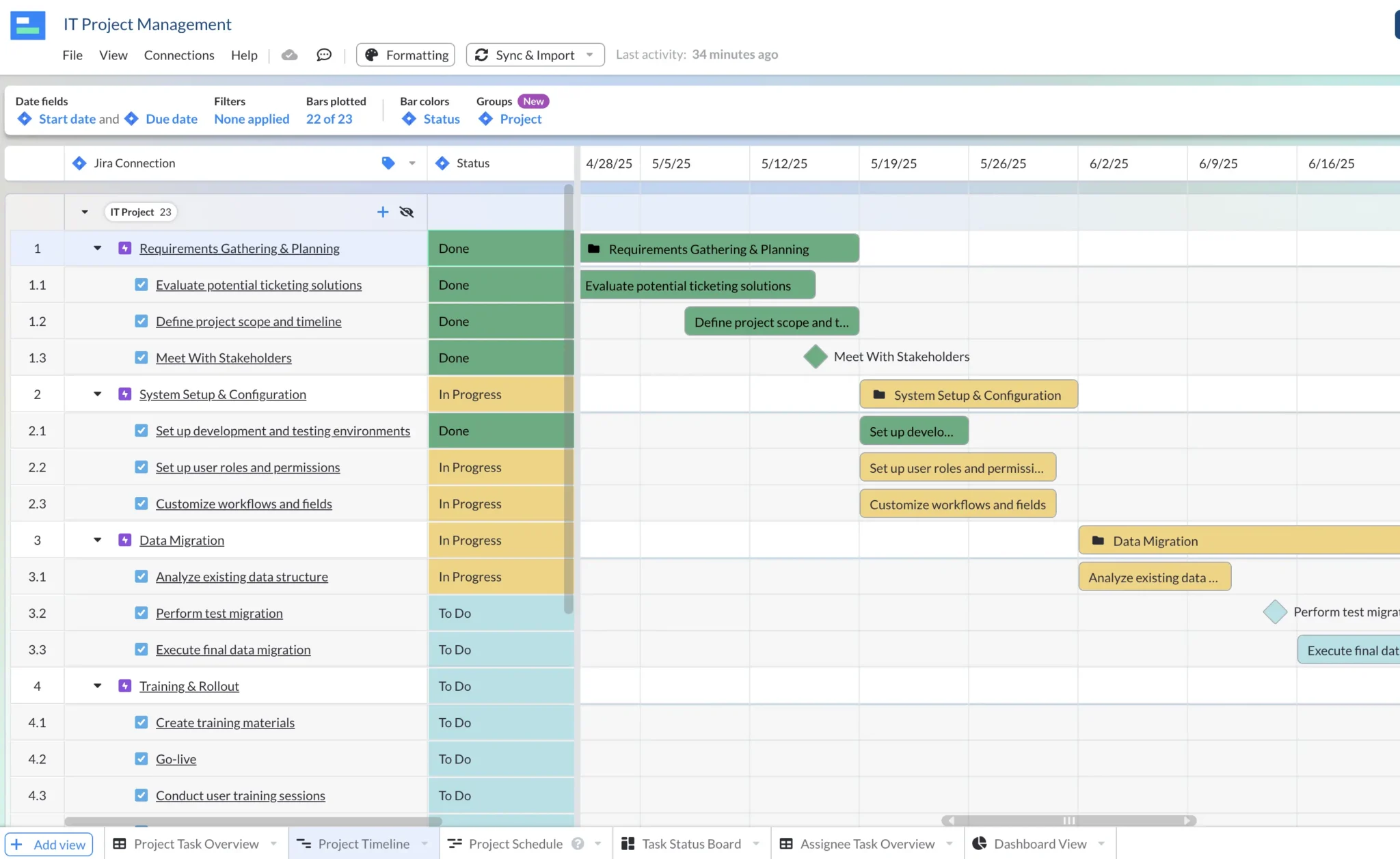
Visor is a particularly good choice for teams using Jira, Asana, or Salesforce, that need a way to create program and portfolio level visualizations with live data from those apps. Visor is a popular alternative to Smartsheet and similar apps that can be used to enhance Jira’s portfolio management capabilities.
Visor’s two-way integrations with apps like Salesforce, Asana, and Jira is completely free (other apps typically make these integrations a chargeable add-on, one of the most expensive is Smartsheet’s Jira connector.
Using Visor you can create real-time portfolio views of your projects and portfolios of projects, including:
- Jira Gantt charts
- Project portfolio roadmaps
- Fully customized portfolio-level Asana dashboards
- Gantt charts containing multiple projects
- A range of other view customizable view types
All these views can be shared with stakeholders, even if they don’t have access to the apps where the projects themselves have been created (such as Jira, Asana, and Salesforce). This enables you to overcome the barriers to sharing and collaboration that these apps place on organizations.
Visor also offers a ton of templates that make it easy to get started, such as templates for IT project plans and an agile project planning template.






